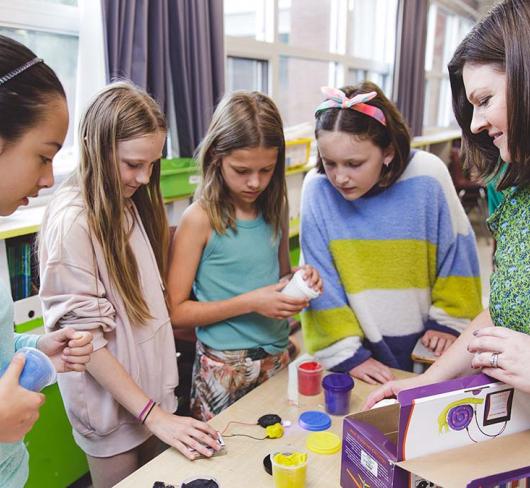
Art Dolls: Expressions of Artistic Equity and Diversity
What is a doll? If you were asked that question, visions of cherubic-faced porcelain dolls, G.I. Joe action figures or perhaps even the latest fad – Monster High dolls – would come to mind. What if someone asked you what an “art doll” was?
I could not have answered that question seven years ago. I had created cloth dolls using published patterns and freehand sewing since I was a child, but when I attended my first doll conference in 2007 in Ottawa, a whole new creative world opened to me. I have since participated in national and local mentoring art doll classes, developed my own doll website, sold dolls at venues across Canada, published work in art doll magazines, and run private spring break and summer art doll classes. I have also taken this passion and passed it on to students at Buchanan Park Elementary School in Hamilton, Ontario. There, doll club members have included boys and girls. The patterns have included simple dolls (no legs but a head and arms), pin dolls (very small dolls) and more complex figurative art dolls.
To put it simply, an art doll is a doll created not primarily as a plaything, but as a piece of art meant to communicate an idea to the observer. Canadian doll artist Adele Sciortino explains this concept related to her work: “Each figurative sculpture is as important as the next, each with their own souls and personalities. I have captured the enlightenment and spirit of true fine arts in the figurative sculpture medium.”
Dolls have been around for centuries in many different cultures. They have played many roles, including as ceremonial objects, representations of deities, burial symbols, commercial figures meant to communicate native costumes and cultural norms, and socialization tools to help children define roles related to gender. American doll artist Elinor Peace-Bailey argues in “The Doll as a Tool” in Art Doll Quarterly (Spring 2011) that dolls became works of art rather than tools when women acquired more leisure time: “For a long time, the art doll did not exist due to the non-existence of leisure time and the repression of women’s art. Think about it? When teaching art, how many female artists or female composers are ever studied? Doll art is still stigmatized by the trivialization of both the female and the child.” By creating art dolls with students, teachers can address this marginalization of women and children artists.
The dolls the students in the Buchanan Park doll club produce are works of art. The children who make the dolls and those who observe the process are aware that doll making is more than a pre-cut craft. The students are so eager to make dolls that names are drawn in order to make the number of participants in the club manageable. In groups of no more than twelve – and even a group that size needs a simple doll pattern – the children meet outside class time once a week until their dolls are finished. Parents, grandparents, former students, teaching colleagues and student mentors help with the club. Their role is not to make the dolls for the students, but to assist them in tasks that require more dexterity, sculptural experience, or perhaps the use of a sewing machine.
What have I learned from observing students making art dolls? I have learned that there is an artist waiting to burst out of every child, regardless of age, gender or school success. Everyone is equal. I have often been surprised by struggling students who – when given a three-dimensional world to play in – produce amazing works of art. Give students freedom and materials and they will create. Childhood produces an artistic single-mindedness that is sometimes lacking in preoccupied adulthood. Children unapologetically want to show and tell; they celebrate artistry. They are not afraid to play with different media and their results show it. To quote Pablo Picasso, “Every child is an artist. The problem is how to remain an artist once we grow up.”
After each doll club, students complete the artistic experience by writing about their doll and by photographing it. What have students learned from making art dolls? Here are some things the children have told me.
“I learned what to use and when to stop. I know when my doll is exactly how I want it to be.” – Xena, 12
Through doll making, students realize that less is more and that every found object or piece of trim does not need to be attached to the doll. This may sound simple, but it is a process of artistic elimination that needs to be explored in order to produce a visually viable work of art.
“I learned that it takes a lot of time to make a doll and that you can pose it in different ways and give it movement.” – Nathalie, 11
Students learn that an art doll is created from the ground up. It is not manufactured; mathematical and artistic skills are needed to cut out a pattern, sew it and embellish it. The process cannot be rushed and everyone works at his or her own pace. If a mistake is made, it is integrated into the design of the doll, keeping in mind that supposed mistakes can work to produce positive effects within the whole piece.
“I was surprised that I could actually make a doll and that I have still kept it after all these years.” – Daniel, 16
Young artists learn to sew with a needle and thread, a skill the majority of children do not have. Students also learn how to work with adhesives and different textiles and assorted media such as cloth, paint and natural fibres. They ponder their creations and take a break from the world of mass production. They communicate and use peer mediation to solve artistic problems, just as our forebears did in their communities while creating quilts and building farms.
“I learned that we are all different like our dolls, and that is a good thing.” – Jordyne, 11
The students cannot help but recognize that although the same pattern is being used for each doll, the results at the end are startlingly different. The dolls are as individual and diverse as their creators. Each figure is intricately connected with the artist’s personality and life. Oddly enough, many of the dolls actually look like the children who made them.
“I learned that there are no rules about what you can and cannot do and that when you use your imagination, you can come up with something completely different from anybody else and that what you start out with isn’t always what you end up with.” – Angel, 11
Perhaps, most importantly, students learn there are no rules. They make their own decisions about what materials they will use and what movements they will depict. They quickly learn that the question “Can I do this?” is followed by the even speedier response “There are no doll police.”
Queens University professor Dr. Rena Upitis supports the importance of free exploration in The Literacy and Numeracy Secretariat’s Research Monograph #33: Engaging Students through the Arts: “The arts allow us to experience the joy of creation and to learn non-verbal ways of expressing thoughts, knowledge and feelings. The arts teach us how to make judgments in the absence of rules; they also teach us that goals are best held with flexibility and that some activities are self-justifying. These are the primary reasons that the arts have a place in our lives and in our schools.”
This view is also reflected in the 2009 revised Ontario arts curriculum: “Participation in the arts contributes in important ways to students’ lives and learning – it involves intense engagement, development of motivation and confidence, and the use of creative and dynamic ways of thinking and knowing. It is well documented that the intellectual and emotional development of children is enhanced through study of the arts.”
I challenge educators to explore the unpredictability and the variation of the arts and, in doing so, to learn more about your students, yourself and the art of doll making.
Dawn Martens is a member of the Hamilton-Wentworth Teacher Local.

